Abstract
1. In aqueous solution above pH7 bilirubin-IXalpha 1-O-acylglucuronide rapidly isomerizes to the non-C-1 glucuronides by sequential migration of the bilirubin acyl group from position 1 to positions 2, 3 and 4 of the sugar moiety. The transformations are enhanced by increasing the pH. Compared with the rates at 37 degrees C the transformations are rather slow at 0 degrees C. Virtually complete inhibition is observed at values below pH6. The isomerization at 25 degrees C and pH 7.4 is not affected by the presence in the solutions of a molar excess of human serum albumin. 2. Isomerization in bile kept at 37 degrees C at pH7.7-7.8 is probably non-enzymic, as the rates of change are similar to those observed under comparable conditions for aqueous solutions of glucuronides of bilirubin-1Xalpha and of azodipyrrole. 3. Analysis without delay of normal biles of man and rats collected at 0 degrees C over a maximum period of 10 min shows that the bilirubin-IXalpha mono- and di-glucuronides consist exclusively of the 1-O-acyl isomers. 4. The mixtures of the four positional isomers of bilirubin-IXalpha glucuronide found in freshly collected biles of man and rats with cholestasis probably originate from initially synthesized 1-O-acylglucuronide by the same mechanism of sequential migration as has been observed in aqueous solutions of conjugated bilirubin-IXalpha.
Full text
PDF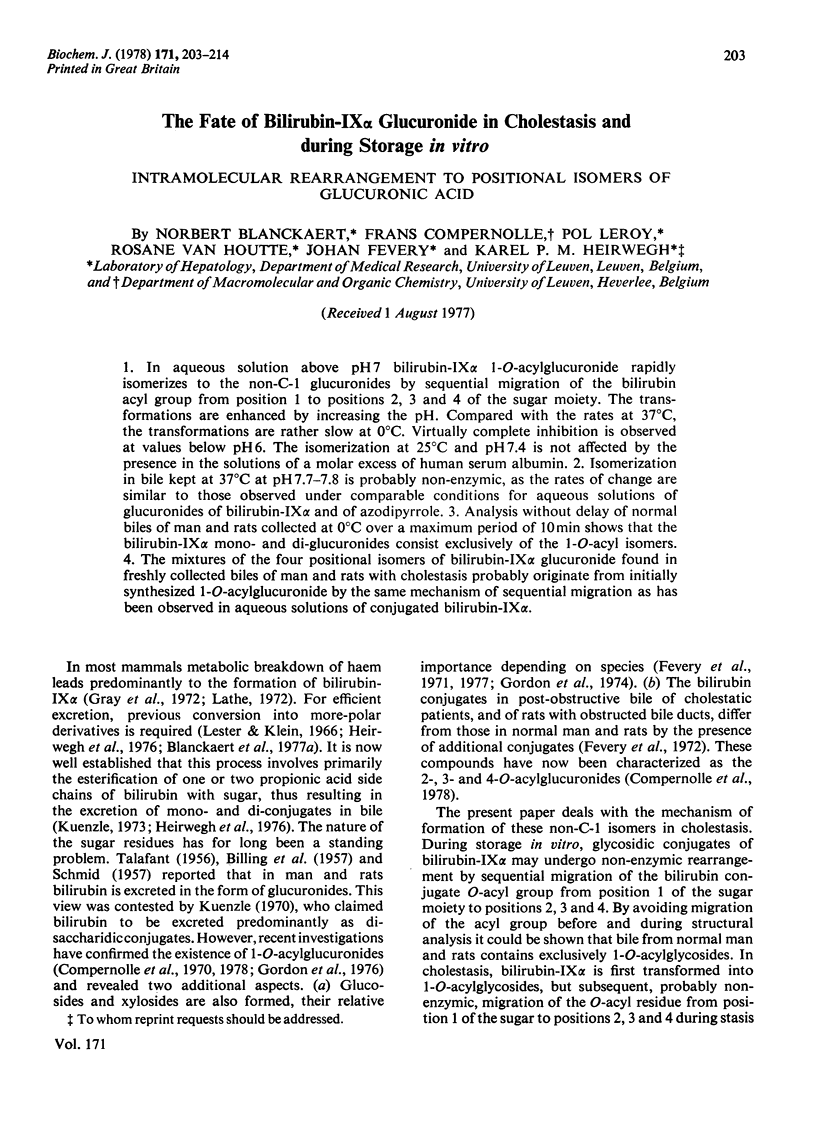
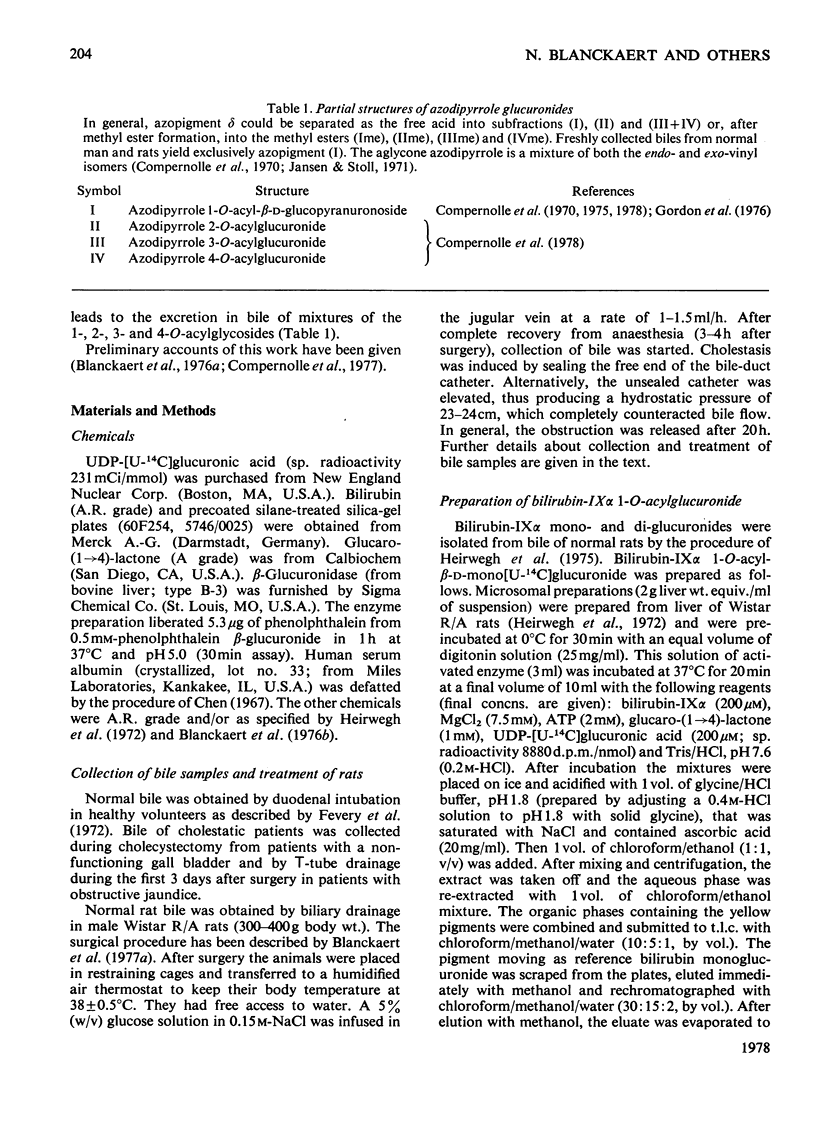
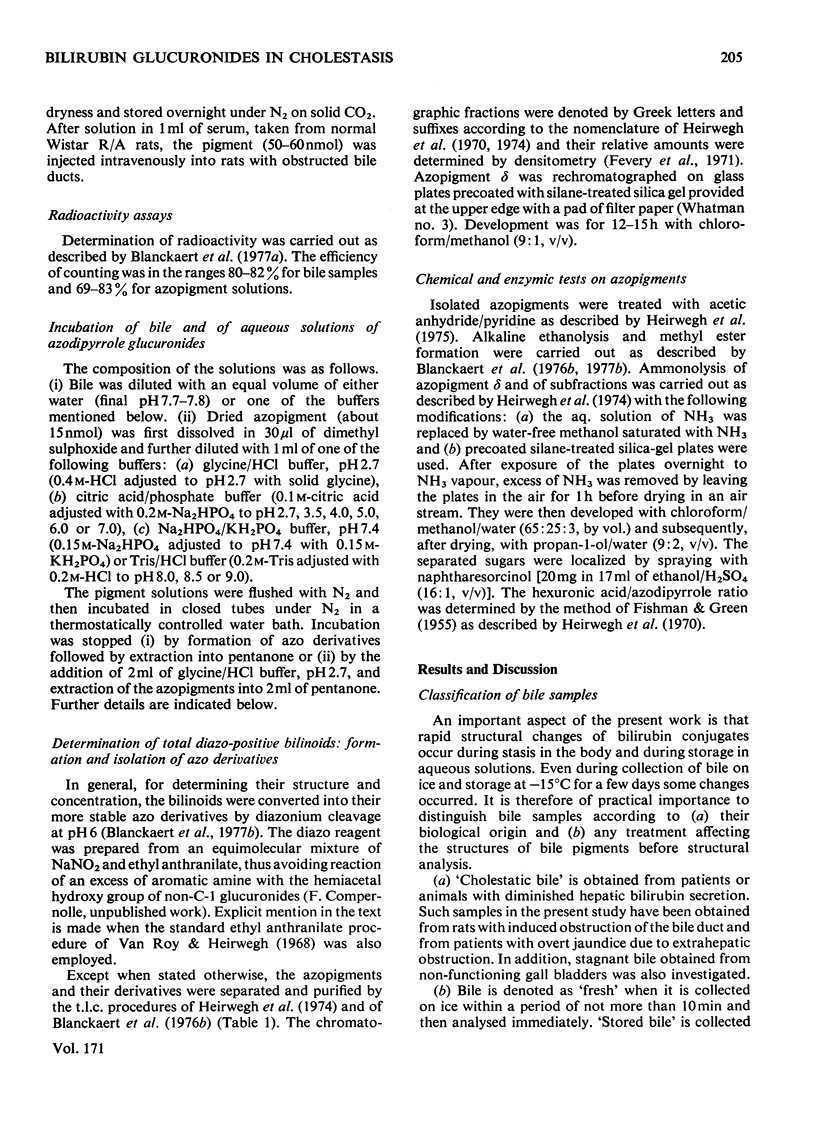
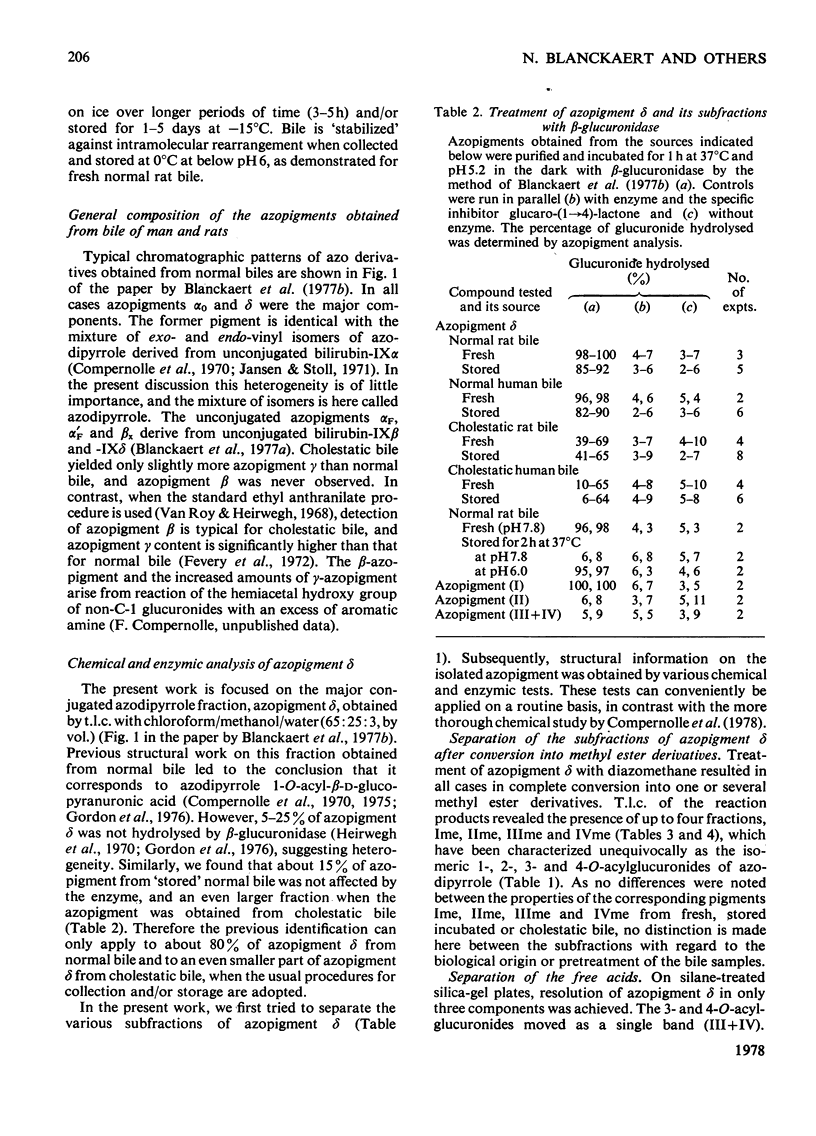
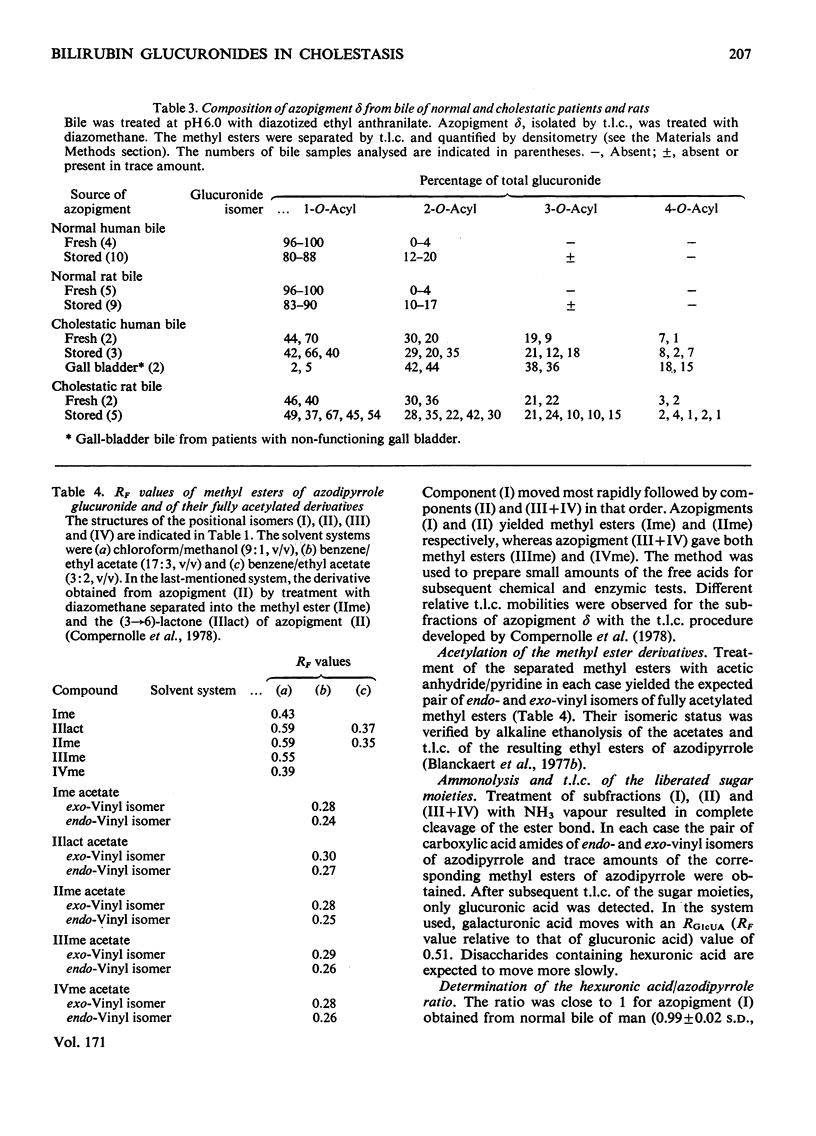
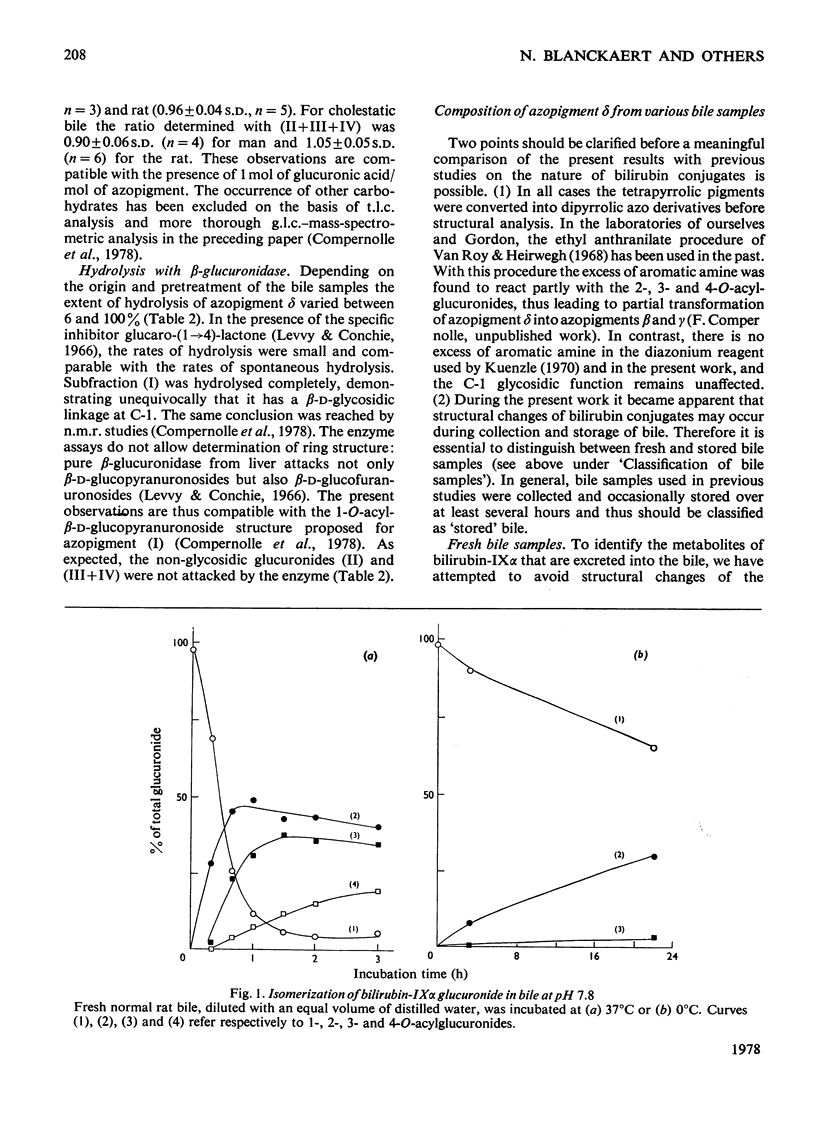
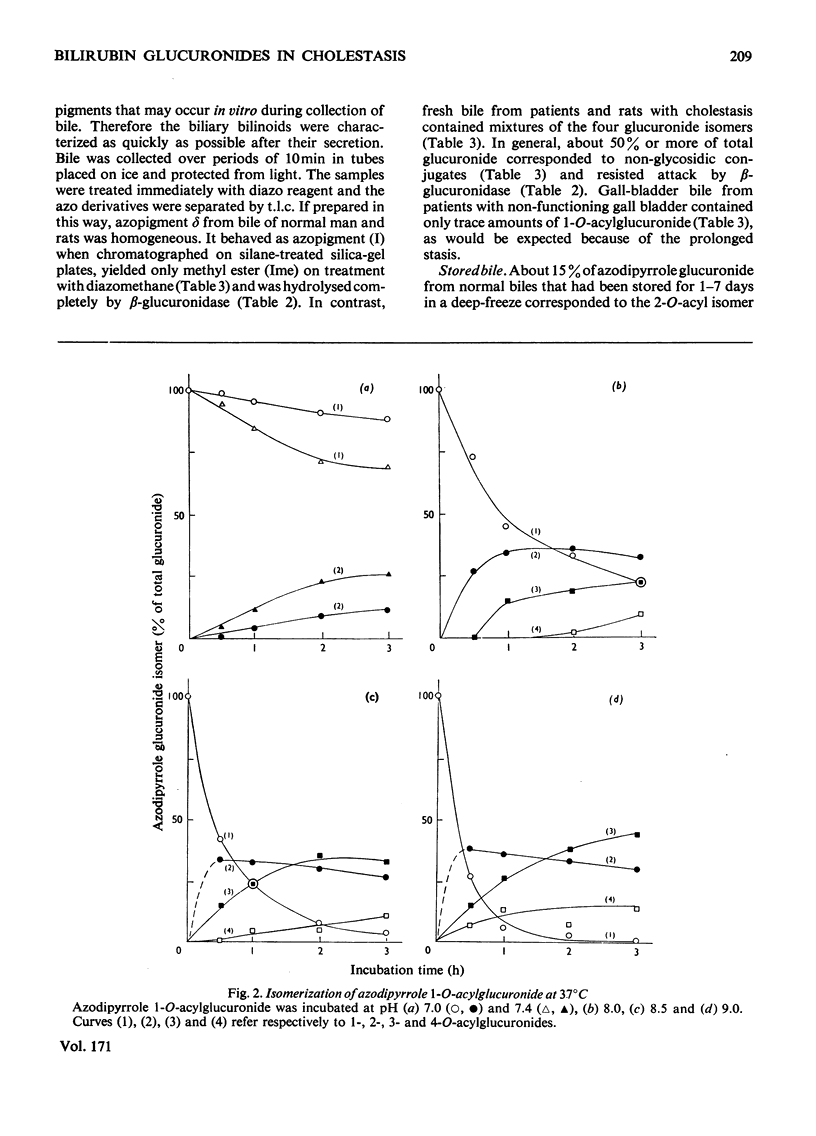
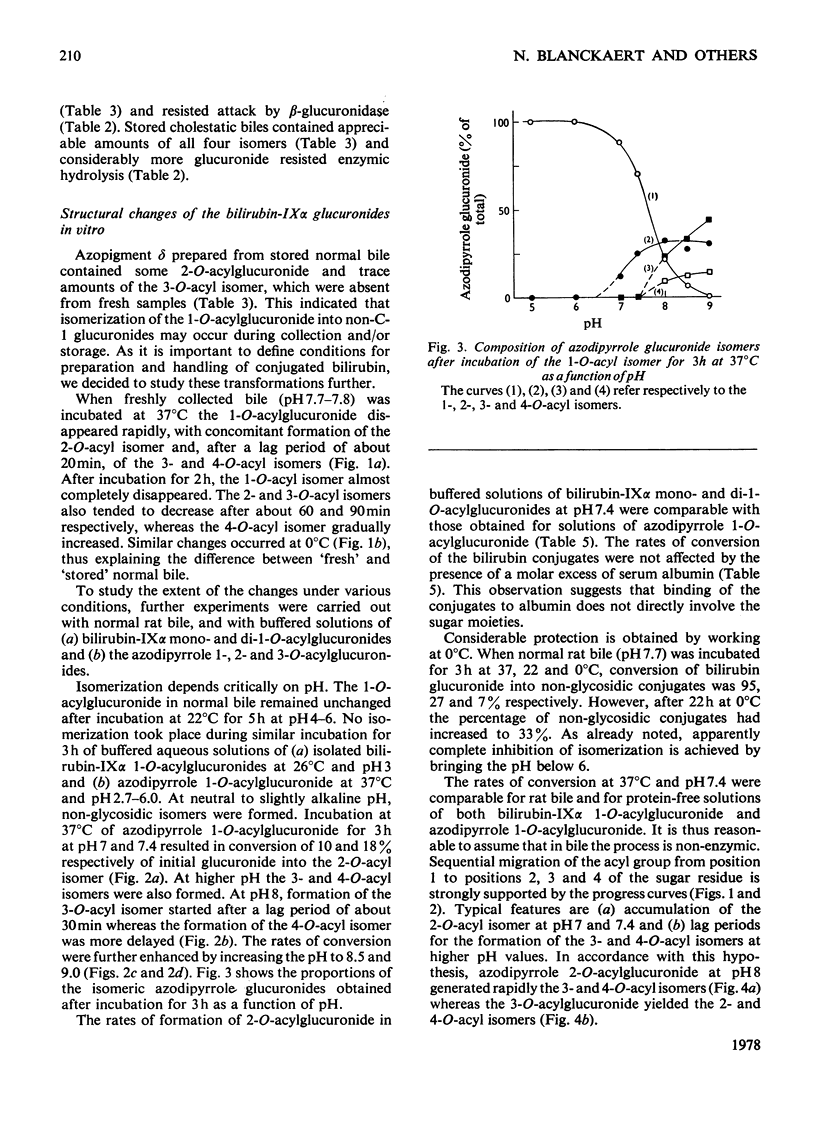
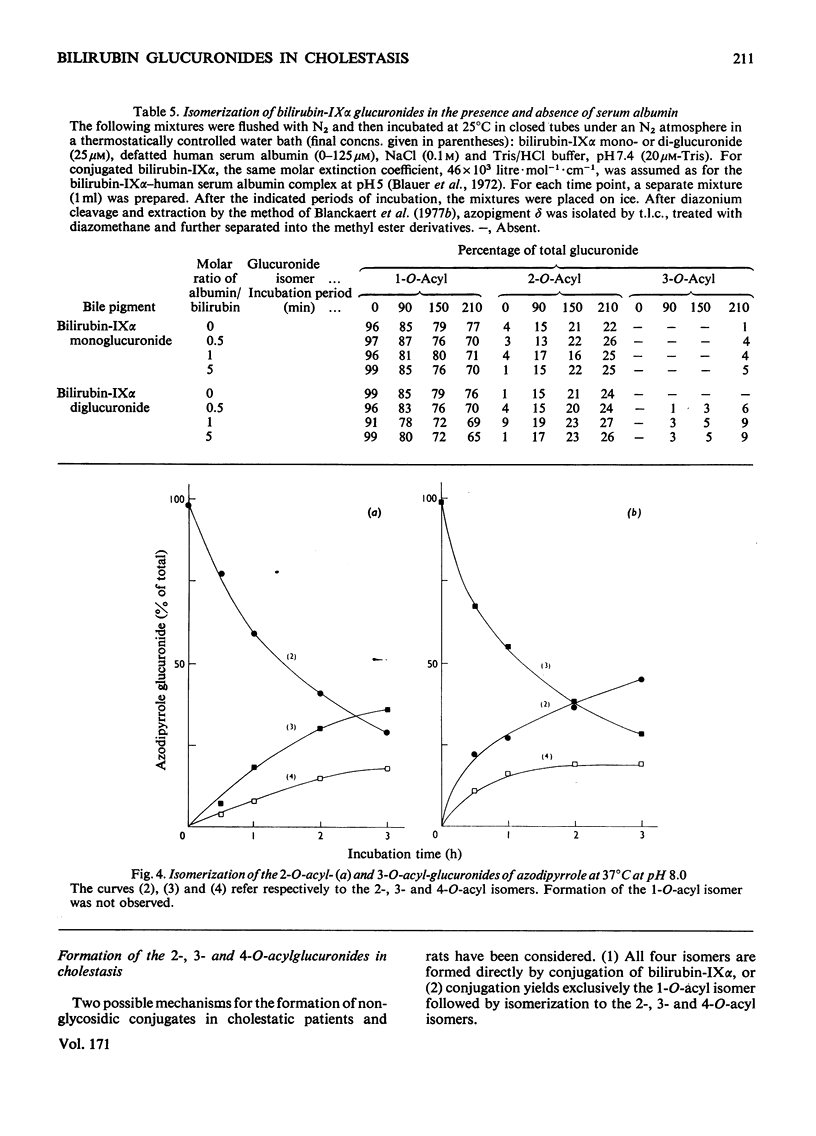
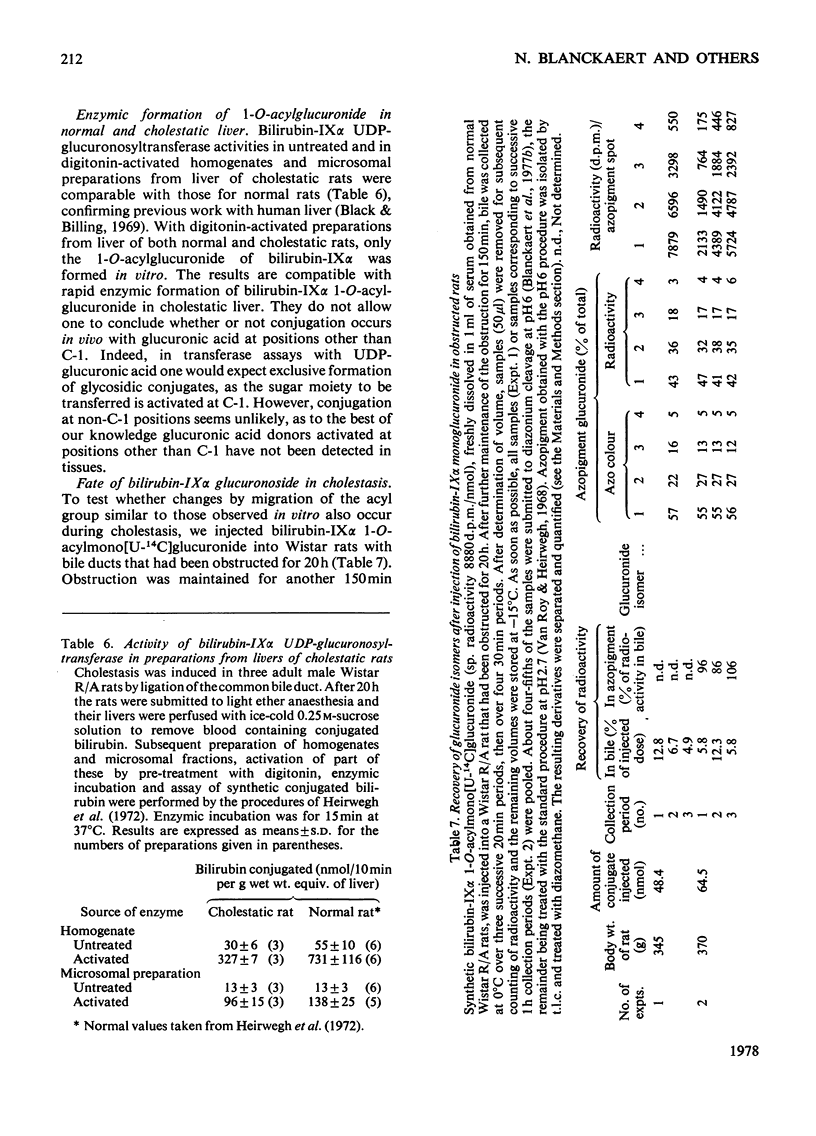
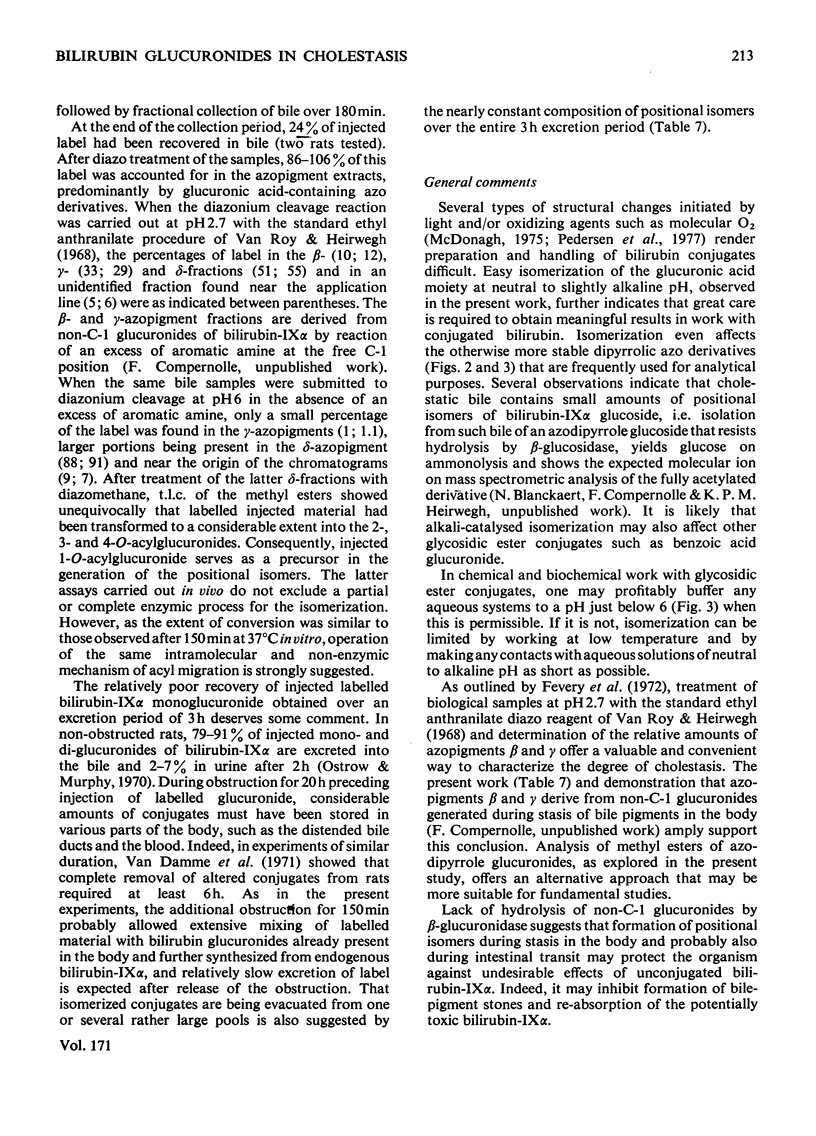
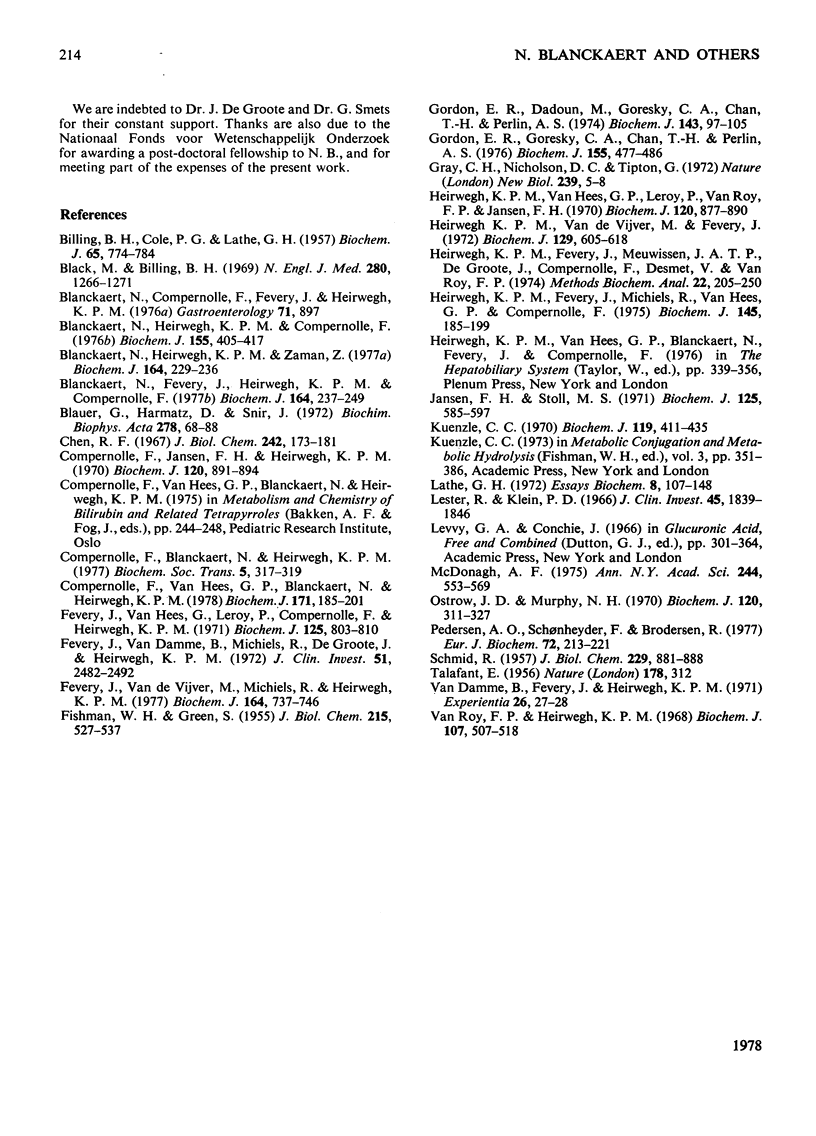
Selected References
These references are in PubMed. This may not be the complete list of references from this article.
- BILLING B. H., COLE P. G., LATHE G. H. The excretion of bilirubin as a diglucuronide giving the direct van den Bergh reaction. Biochem J. 1957 Apr;65(4):774–784. doi: 10.1042/bj0650774. [DOI] [PMC free article] [PubMed] [Google Scholar]
- Black M., Billing B. H. Hepatic bilirubin udp-glucuronyl transferase activity in liver disease and gilbert's syndrome. N Engl J Med. 1969 Jun 5;280(23):1266–1271. doi: 10.1056/NEJM196906052802303. [DOI] [PubMed] [Google Scholar]
- Blanckaert N., Fevery J., Heirwegh K. P., Compernolle F. Characterization of the major diazo-positive pigments in bile of homozygous Gunn rats. Biochem J. 1977 Apr 15;164(1):237–249. doi: 10.1042/bj1640237. [DOI] [PMC free article] [PubMed] [Google Scholar]
- Blanckaert N., Heirwegh K. P., Compernolle F. Synthesis and separation by thin-layer chromatography of bilirubin-IX isomers. Their identification as tetrapyrroles and dipyrrolic ethyl anthranilate azo derivatives. Biochem J. 1976 May 1;155(2):405–417. doi: 10.1042/bj1550405. [DOI] [PMC free article] [PubMed] [Google Scholar]
- Blanckaert N., Heirwegh K. P., Zaman Z. Comparison of the biliary excretion of the four isomers of bilirubin-IX in Wistar and homozygous Gunn rats. Biochem J. 1977 Apr 15;164(1):229–236. doi: 10.1042/bj1640229. [DOI] [PMC free article] [PubMed] [Google Scholar]
- Blauer G., Harmatz D., Snir J. Optical properties of bilirubin-serum albumin complexes in aqueous solution. I. Dependence on pH. Biochim Biophys Acta. 1972 Aug 31;278(1):68–88. doi: 10.1016/0005-2795(72)90108-0. [DOI] [PubMed] [Google Scholar]
- Chen R. F. Removal of fatty acids from serum albumin by charcoal treatment. J Biol Chem. 1967 Jan 25;242(2):173–181. [PubMed] [Google Scholar]
- Compernolle F., Blanckaert N., Heirwegh K. P. The fate of bilirubin-IXalpha glucuronides in cholestatic bile: sequential migration of the 1-acylaglycone to the 2-, 3- and 4- positions of glucuronic acid. Biochem Soc Trans. 1977;5(1):317–319. doi: 10.1042/bst0050317. [DOI] [PubMed] [Google Scholar]
- Compernolle F., Jansen F. H., Heirwegh K. P. Mass-spectrometric study of the azopigments obtained from bile pigments with diazotized ethyl anthranilate. Biochem J. 1970 Dec;120(4):891–894. doi: 10.1042/bj1200891. [DOI] [PMC free article] [PubMed] [Google Scholar]
- Compernolle F., Van Hees G. P., Blanckaert N., Heirwegh K. P. Glucuronic acid conjugates of bilirubin-IXalpha in normal bile compared with post-obstructive bile. Transformation of the 1-O-acylglucuronide into 2-, 3-, and 4-O-acylglucuronides. Biochem J. 1978 Apr 1;171(1):185–201. doi: 10.1042/bj1710185. [DOI] [PMC free article] [PubMed] [Google Scholar]
- FISHMAN W. H., GREEN S. Microanalysis of glucuronide glucuronic acid as applied to beta-glucuronidase and glucuronic acid studies. J Biol Chem. 1955 Aug;215(2):527–537. [PubMed] [Google Scholar]
- Fevery J., Van Damme B., Michiels R., De Groote J., Heirwegh K. P. Bilirubin conjugates in bile of man and rat in the normal state and in liver disease. J Clin Invest. 1972 Sep;51(9):2482–2492. doi: 10.1172/JCI107062. [DOI] [PMC free article] [PubMed] [Google Scholar]
- Fevery J., Van Hees G. P., Leroy P., Compernolle F., Heirwegh K. P. Excretion in dog bile of glucose and xylose conjugates of bilirubin. Biochem J. 1971 Dec;125(3):803–810. doi: 10.1042/bj1250803. [DOI] [PMC free article] [PubMed] [Google Scholar]
- Fevery J., Van de Vijver M., Michiels R., Heirwegh K. P. Comparison in different species of biliary bilirubin-IX alpha conjugates with the activities of hepatic and renal bilirubin-IX alpha-uridine diphosphate glycosyltransferases. Biochem J. 1977 Jun 15;164(3):737–746. doi: 10.1042/bj1640737. [DOI] [PMC free article] [PubMed] [Google Scholar]
- Gordon E. R., Dadoun M., Goresky C. A., Chan T. H., Perlin A. S. The isolation of an azobilirubin beta-D-monoglucoside from dog gall-bladder bile. Biochem J. 1974 Oct;143(1):97–105. doi: 10.1042/bj1430097. [DOI] [PMC free article] [PubMed] [Google Scholar]
- Gordon E. R., Goresky C. A., Chang T. H., Perlin A. S. The isolation and characterization of bilirubin diglucuronide, the major bilirubin conjugate in dog and human bile. Biochem J. 1976 Jun 1;155(3):477–486. doi: 10.1042/bj1550477. [DOI] [PMC free article] [PubMed] [Google Scholar]
- Gray C. H., Nicholson D. C., Tipton G. Degradation of haem compounds to bile pigments. Nat New Biol. 1972 Sep 6;239(88):5–8. doi: 10.1038/newbio239005a0. [DOI] [PubMed] [Google Scholar]
- Heirwegh K. P., Fevery J., Meuwissen J. A., De Groote J., Compernolle F., Desmet V., Van Roy F. P. Recent advances in the separation and analysis of diazo-positive bile pigments. Methods Biochem Anal. 1974;22:205–250. doi: 10.1002/9780470110423.ch5. [DOI] [PubMed] [Google Scholar]
- Heirwegh K. P., Fevery J., Michiels R., van Hees G. P., Compernolle F. Separation by thin-layer chromatography and structure elucidation of bilirubin conjugates isolated from dog bile. Biochem J. 1975 Feb;145(2):185–199. doi: 10.1042/bj1450185. [DOI] [PMC free article] [PubMed] [Google Scholar]
- Heirwegh K. P., Van Hees G. P., Leroy P., Van Roy F. P., Jansen F. H. Heterogeneity of bile pigment conjugates as revealed by chromatography of their ethyl anthranilate azopigments. Biochem J. 1970 Dec;120(4):877–890. doi: 10.1042/bj1200877. [DOI] [PMC free article] [PubMed] [Google Scholar]
- Heirwegh K. P., Van de Vijver M., Fevery J. Assay and properties of dititonin-activated bilirubin uridine diphosphate glucuronyltransferase from rat liver. Biochem J. 1972 Sep;129(3):605–618. doi: 10.1042/bj1290605. [DOI] [PMC free article] [PubMed] [Google Scholar]
- Jansen F. H., Stoll M. S. Separation and structural analysis of vinyl- and isovinyl-azobilirubin derivatives. Biochem J. 1971 Nov;125(2):585–597. doi: 10.1042/bj1250585. [DOI] [PMC free article] [PubMed] [Google Scholar]
- Kuenzle C. C. Bilirubin conjugates of human bile. The excretion of bilirubin as the acyl glycosides of aldobiouronic acid, pseudoaldobiouronic acid and hexuronosylhexuronic acid, with a branched-chain hexuronic acid as one of the components of the hexuronosylhexuronide. Biochem J. 1970 Sep;119(3):411–435. doi: 10.1042/bj1190411. [DOI] [PMC free article] [PubMed] [Google Scholar]
- Lathe G. H. The degradation of haem by mammals and its excretion as conjugated bilirubin. Essays Biochem. 1972;8:107–148. [PubMed] [Google Scholar]
- Lester R., Klein P. D. Bile pigment excretion: a comparison of the biliary excretion of bilirubin and bilirubin derivatives. J Clin Invest. 1966 Dec;45(12):1839–1846. doi: 10.1172/JCI105487. [DOI] [PMC free article] [PubMed] [Google Scholar]
- McDonagh A. F. Thermal and photochemical reactions of bilirubin IX-alpha. Ann N Y Acad Sci. 1975 Apr 15;244:553–569. doi: 10.1111/j.1749-6632.1975.tb41554.x. [DOI] [PubMed] [Google Scholar]
- Ostrow J. D., Murphy N. H. Isolation and properties of conjugated bilirubin from bile. Biochem J. 1970 Nov;120(2):311–327. doi: 10.1042/bj1200311. [DOI] [PMC free article] [PubMed] [Google Scholar]
- Pedersen A. O., Schonheyder F., Brodersen R. Photooxidation of human serum albumin and its complex with bilirubin. Eur J Biochem. 1977 Jan;72(2):213–221. doi: 10.1111/j.1432-1033.1977.tb11242.x. [DOI] [PubMed] [Google Scholar]
- SCHMID R. The identification of direct-reacting bilirubin as bilirubin glucuronide. J Biol Chem. 1957 Dec;229(2):881–888. [PubMed] [Google Scholar]
- TALAFANT E. Properties and composition of the bile pigment giving a direct diazo reaction. Nature. 1956 Aug 11;178(4528):312–312. doi: 10.1038/178312a0. [DOI] [PubMed] [Google Scholar]
- Van Damme B., Fevery J., Heirwegh K. P. Altered composition of bilirubin conjugates in rat bile after obstruction of the common bile duct. Experientia. 1971 Jan 15;27(1):27–28. doi: 10.1007/BF02137721. [DOI] [PubMed] [Google Scholar]
- Van Roy F. P., Heirwegh K. P. Determination of bilirubin glucuronide and assay of glucuronyltransferase with bilirubin as acceptor. Biochem J. 1968 Apr;107(4):507–518. doi: 10.1042/bj1070507. [DOI] [PMC free article] [PubMed] [Google Scholar]


